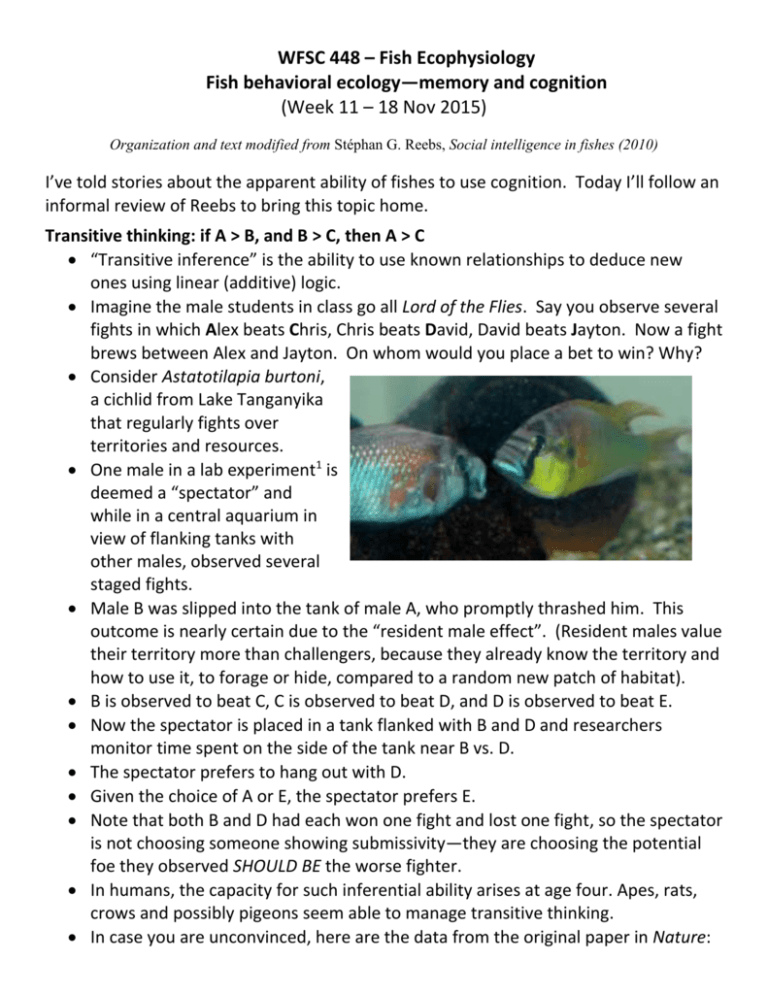2015 Week 11 - Fish behavioral ecology--memory and
advertisement

WFSC 448 – Fish Ecophysiology Fish behavioral ecology—memory and cognition (Week 11 – 18 Nov 2015) Organization and text modified from Stéphan G. Reebs, Social intelligence in fishes (2010) I’ve told stories about the apparent ability of fishes to use cognition. Today I’ll follow an informal review of Reebs to bring this topic home. Transitive thinking: if A > B, and B > C, then A > C “Transitive inference” is the ability to use known relationships to deduce new ones using linear (additive) logic. Imagine the male students in class go all Lord of the Flies. Say you observe several fights in which Alex beats Chris, Chris beats David, David beats Jayton. Now a fight brews between Alex and Jayton. On whom would you place a bet to win? Why? Consider Astatotilapia burtoni, a cichlid from Lake Tanganyika that regularly fights over territories and resources. One male in a lab experiment1 is deemed a “spectator” and while in a central aquarium in view of flanking tanks with other males, observed several staged fights. Male B was slipped into the tank of male A, who promptly thrashed him. This outcome is nearly certain due to the “resident male effect”. (Resident males value their territory more than challengers, because they already know the territory and how to use it, to forage or hide, compared to a random new patch of habitat). B is observed to beat C, C is observed to beat D, and D is observed to beat E. Now the spectator is placed in a tank flanked with B and D and researchers monitor time spent on the side of the tank near B vs. D. The spectator prefers to hang out with D. Given the choice of A or E, the spectator prefers E. Note that both B and D had each won one fight and lost one fight, so the spectator is not choosing someone showing submissivity—they are choosing the potential foe they observed SHOULD BE the worse fighter. In humans, the capacity for such inferential ability arises at age four. Apes, rats, crows and possibly pigeons seem able to manage transitive thinking. In case you are unconvinced, here are the data from the original paper in Nature: Similarly… When two rainbow trout fight in front of a spectator fish behind a one-way mirror, the spectator was observed to treat the winner and loser of the first fight differently. When paired with the familiar dominant, the former spectator reached a decision more quickly about how to proceed: either it gave up earlier (eventually losing the fight) or it escalated the fight earlier (eventually winning). It was as if the former spectator had already made up its mind, based on the previous viewing, whether it was weaker or stronger than the dominant. In contrast, when paired with an unfamiliar contestant, former spectators fought more tentatively, and it took a longer time for a winner to finally emerge.3 In a similar vein, Siamese fighting fish Betta splendens and green swordtails Xiphophorus hellerii are more willing to engage the loser rather than the winner of a fight they have just witnessed, while they show no such discrimination between the winner and loser of a contest they have not witnessed.4 Transferrence of Stimulus Threespot gouramis Trichogaster trichopterus form dominance hierarchies, which are evident when food is dropped in the water: dominants monopolize the food by attacking submissives who try to feed. Subordinates adopt a typical submissive posture (body angled downward with fins folded and pallid coloration) In an experiment, dominants and subordinates who knew each other were separated and isolated. Each learned to associate a signal (a light being turned on) with the imminent arrival of food. Then pairs of fish were formed by reuniting a subordinate with a dominant. The light was turned on. In each pair the dominants went to the surface as usual. But the subordinates did not; instead most of them immediately adopted the submissive posture, even though food had not arrived yet. The subordinates knew that light signaled food, and they knew that food meant being beaten up by dominants. As soon as the light came on they anticipated being beaten up and right away they took measures to appease the dominants. The apparently cognitive feat here is to jump from a learned association related to feeding and transferring the association to a new stimulus. Remembering rivals Fish can recognize and remember individuals they already fought with (a more direct interaction than simply watching, as in the section above). The typical experimental procedure here is to pit two fish against each other and let them fight it out. Then the loser is removed and the winner is left alone. A few days later, the winner is made to encounter either the fish it has defeated earlier or another individual it has never met before (to even things out, one has to make sure that this new individual has also been defeated by another fish a few days earlier). The usual outcome is less aggression takes place between two protagonists who already met as opposed to two who have never met. This implies the two acquaintances recognize each other and remember how they stand relative to each other. Among the species for which this is true are sticklebacks, trout, swordtails, cichlids, and paradise fish.5 Similarly, territorial neighbours remember one another and put a brake on their bickering once their territories have become established. This phenomenon is called the “dear enemy effect”.6 If one territory owner is experimentally replaced by another fish, all neighbours become aggressive towards this newcomer, which shows that the previous lack of aggression was not based on fatigue but indeed on the recognition of a familiar neighbour. By substituting dear enemies with strangers, researchers can determine how neighbours recognize one another. For many species, visual appearance is enough. For example, territorial sticklebacks display aggressively to a new neighbour even when the latter is in a separate aquarium a short distance away. Similarly, three-spot damselfish Stegastes planifrons on a reef direct more attacks at bottles that containnew fish as opposed to regular neighbours.7 For yellow bullhead it is the scent of a known dominant fish that is enough to trigger fearful reactions.8 Neighbours can also be distinguished on the basis of their personal calls9 and electric discharges.10 The dear enemy effect may work for predators as well. Your instructor discovered that mosquitofish from populations having predatory sunfish treated the sunfish with greater DISregard than mosquitofish from populations lacking predatory sunfish. It was as if the mosquitofish from predator populations were less worried about the predator as they had more confidence in knowing how, or physically being adapted to deal with it.









